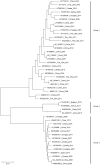Porcine Bocavirus: A 10-Year History since Its Discovery
- PMID: 33909219
- PMCID: PMC8080206
- DOI: 10.1007/s12250-021-00365-z
Porcine Bocavirus: A 10-Year History since Its Discovery
Abstract
Porcine bocavirus (PBoV) is a single-stranded DNA virus, belongs to the genus Bocaparvovirus of family Parvoviridae. It was discovered along with porcine circovirus 2 (PCV 2) and torque tenovirus (TTV) in the lymph nodes of pigs suffering from postweaning multisystemic wasting syndrome (PMWS) in Sweden in 2009. PBoV has been reported throughout the world, mostly in weaning piglets, and has a broad range of tissue tropism. Since PBoV is prevalent in healthy as well as clinically infected pigs and is mostly associated with coinfection with other viruses, the pathogenic nature of PBoV is still unclear. Currently, there are no cell lines available for the study of PBoV, and animal model experiments have not been described. This review summarizes the current state of knowledge about PBoV, including the epidemiology, evolution analysis, detection methods, pathogenesis and public health concerns.
Keywords: Coinfection; Detection; Emerging pathogen; Epidemiology; Evolution; Pathogenesis; Porcine bocavirus (PBoV); Public health concerns.
© 2021. Wuhan Institute of Virology, CAS.
Conflict of interest statement
The authors declare that they have no competing interests.
Figures



Similar articles
-
Studies of porcine circovirus type 2, porcine boca-like virus and torque teno virus indicate the presence of multiple viral infections in postweaning multisystemic wasting syndrome pigs.Virus Res. 2010 Sep;152(1-2):59-64. doi: 10.1016/j.virusres.2010.06.004. Epub 2010 Jun 11. Virus Res. 2010. PMID: 20542066
-
Evolutionary, epidemiological, demographical, and geographical dissection of porcine bocavirus in China and America.Virus Res. 2015 Jan 2;195:13-24. doi: 10.1016/j.virusres.2014.09.012. Epub 2014 Oct 5. Virus Res. 2015. PMID: 25289962
-
Co-infection with porcine bocavirus and porcine circovirus 2 affects inflammatory cytokine production and tight junctions of IPEC-J2 cells.Virus Genes. 2018 Oct;54(5):684-693. doi: 10.1007/s11262-018-1596-6. Epub 2018 Sep 1. Virus Genes. 2018. PMID: 30173363
-
[Research advances in porcine bocavirus].Bing Du Xue Bao. 2012 Mar;28(2):190-3. Bing Du Xue Bao. 2012. PMID: 22519183 Review. Chinese.
-
Postweaning multisystemic wasting syndrome (PMWS) in pigs with particular emphasis on the causative agent, the mode of transmission, the diagnostic tools and the control measures. A review.Vet Q. 2005 Sep;27(3):105-16. doi: 10.1080/01652176.2005.9695191. Vet Q. 2005. PMID: 16238110 Review.
Cited by
-
Polymerase chain reaction-based detection of coinfecting DNA viruses in Vietnamese pigs in 2017 and 2021.Vet World. 2022 Oct;15(10):2491-2498. doi: 10.14202/vetworld.2022.2491-2498. Epub 2022 Oct 29. Vet World. 2022. PMID: 36425131 Free PMC article.
-
Assessment on the efficacy of methods 2 to 5 and method 7 set out in Commission Regulation (EU) No 142/2011 to inactivate relevant pathogens when producing processed animal protein of porcine origin intended to feed poultry and aquaculture animals.EFSA J. 2023 Jul 5;21(7):e08093. doi: 10.2903/j.efsa.2023.8093. eCollection 2023 Jul. EFSA J. 2023. PMID: 37416785 Free PMC article.
-
Structural Characterization of Canine Minute Virus, Rat and Porcine Bocavirus.Viruses. 2023 Aug 24;15(9):1799. doi: 10.3390/v15091799. Viruses. 2023. PMID: 37766206 Free PMC article.
-
Small but mighty: old and new parvoviruses of veterinary significance.Virol J. 2021 Oct 24;18(1):210. doi: 10.1186/s12985-021-01677-y. Virol J. 2021. PMID: 34689822 Free PMC article. Review.
-
Current Insights into Porcine Bocavirus (PBoV) and Its Impact on the Economy and Public Health.Vet Sci. 2024 Dec 22;11(12):677. doi: 10.3390/vetsci11120677. Vet Sci. 2024. PMID: 39729017 Free PMC article. Review.
References
-
- Anne Christin Böhmer V, Lüsebrink J, Ziegler S, Tillmann RL, Kleines M, Schildgen O. Novel application for isothermal nucleic acid sequence-based amplification (NASBA) J Virol Methods. 2009;158:199–201. - PubMed
Publication types
MeSH terms
LinkOut - more resources
Full Text Sources
Other Literature Sources

